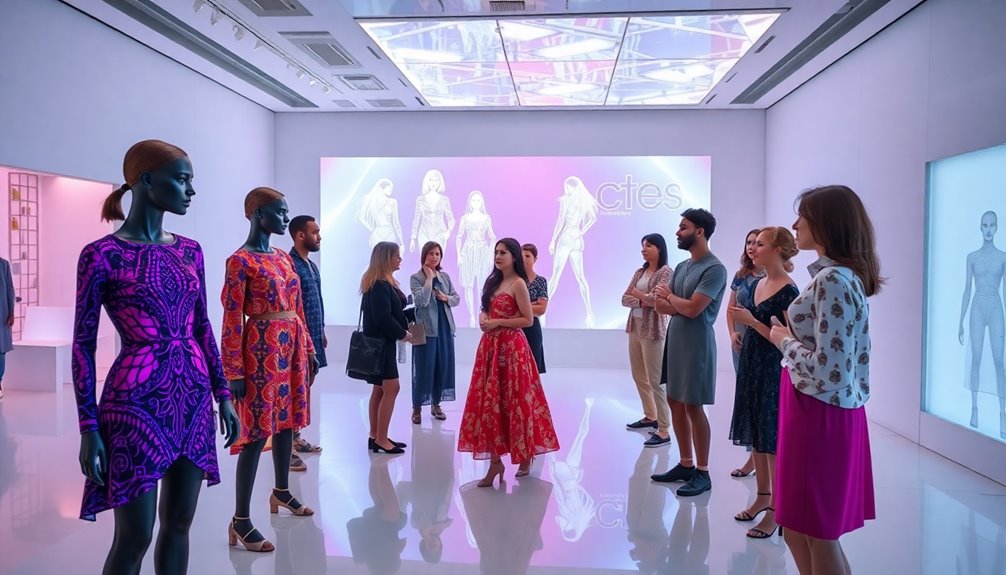Yes, AI is the future of fashion! It streamlines supply chains, improves sustainability, and enhances the customer experience. With AI, brands can forecast demand effectively, minimizing waste and emissions. Technologies like virtual try-ons personalize shopping, while generative AI helps predict trends and create unique designs. However, the rapid production has risks, including overconsumption and ethical labor concerns. Collaboration with AI experts is key to harnessing its benefits responsibly. As you explore further, you'll uncover insights on how AI is shaping every facet of the fashion industry and what that means for you as a consumer.
Key Takeaways
- AI enhances supply chain efficiency by improving demand forecasting and inventory management, reducing waste in the fashion industry.
- The integration of AI in fashion design promotes sustainability, enabling brands to minimize carbon emissions and adopt eco-friendly practices.
- AI-driven technologies enhance consumer experiences through personalized recommendations and virtual try-ons, increasing customer satisfaction and loyalty.
- Generative AI allows for rapid design creation, predicting trends while fostering innovation through strategic collaborations with tech experts.
- Ethical considerations, including copyright protection and labor standards, are essential as AI transforms the fashion landscape to prevent exploitation and uphold creative rights.
AI's Role in Fashion Supply Chains
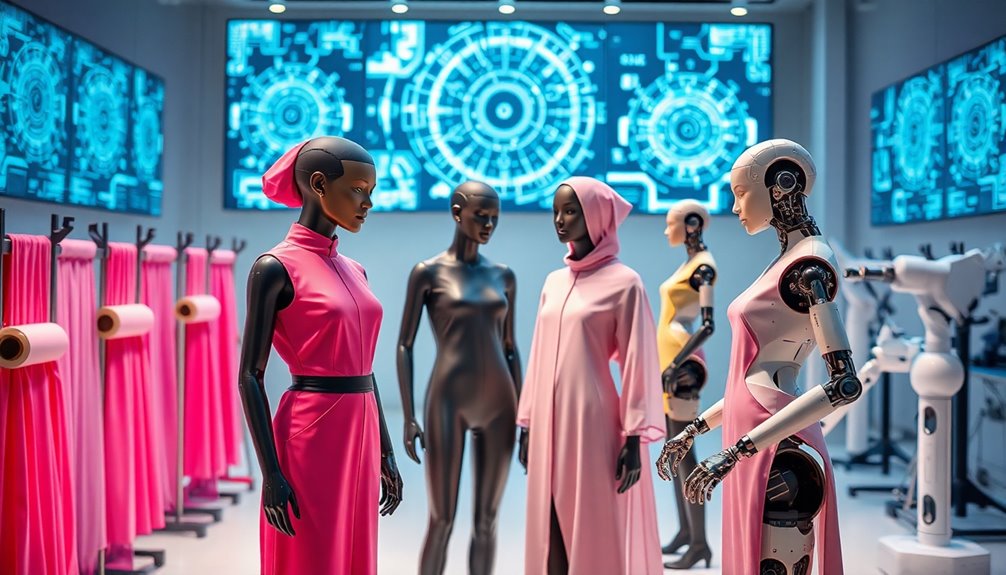
As fashion brands increasingly embrace AI, they're revolutionizing supply chains in ways you mightn't expect.
AI enhances demand forecasting, allowing fashion companies like Shein to monitor real-time customer demand. This capability enables them to produce small batches that align with consumer preferences, reducing inventory waste considerably.
With over 600,000 items listed at any time, Shein leverages AI-driven data analytics for optimized inventory management, improving product availability.
Additionally, machine-learning technologies like Smartex.Ai help identify and reduce fabric defects, minimizing waste in the supply chain.
Sustainability and Environmental Impact
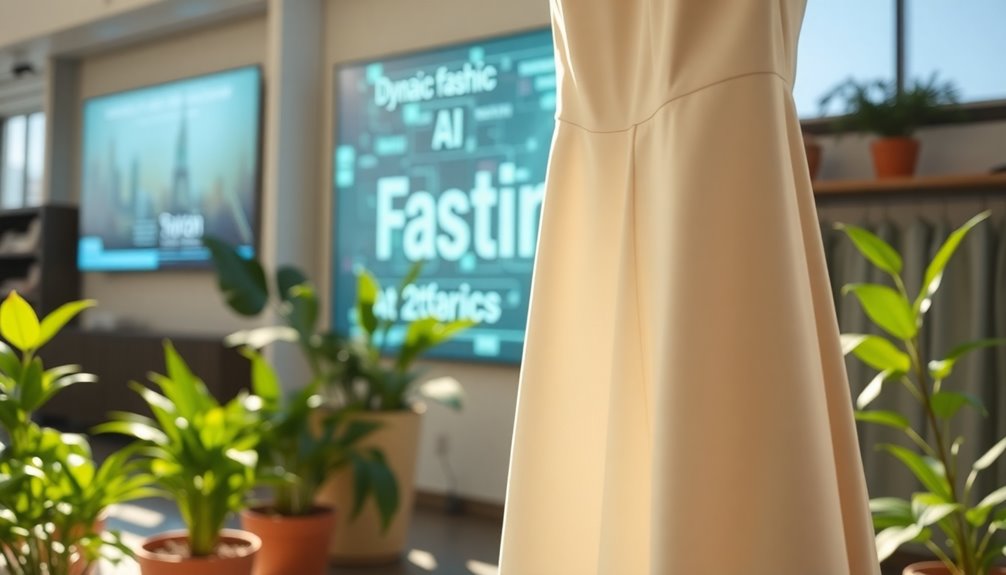
While the fashion industry has long been criticized for its environmental impact, recent advancements in AI offer a glimmer of hope for a more sustainable future.
AI-driven technologies, like Smartex.Ai, help identify fabric defects, minimizing waste and enhancing material efficiency in production. This can notably reduce the carbon footprint that fast fashion brands, such as Shein, contribute—around 1.2 billion tonnes annually.
With Shein aiming to cut its emissions by 25% by 2030, the push for sustainability is becoming increasingly essential. However, experts caution that without ethical standards, the efficiency gained from AI could inadvertently lead to overconsumption.
It's imperative to balance innovation with responsibility to truly transform the fashion industry's environmental impact. Additionally, the adoption of sustainable practices in production could further mitigate the industry's negative effects on the planet.
Risks of Overconsumption
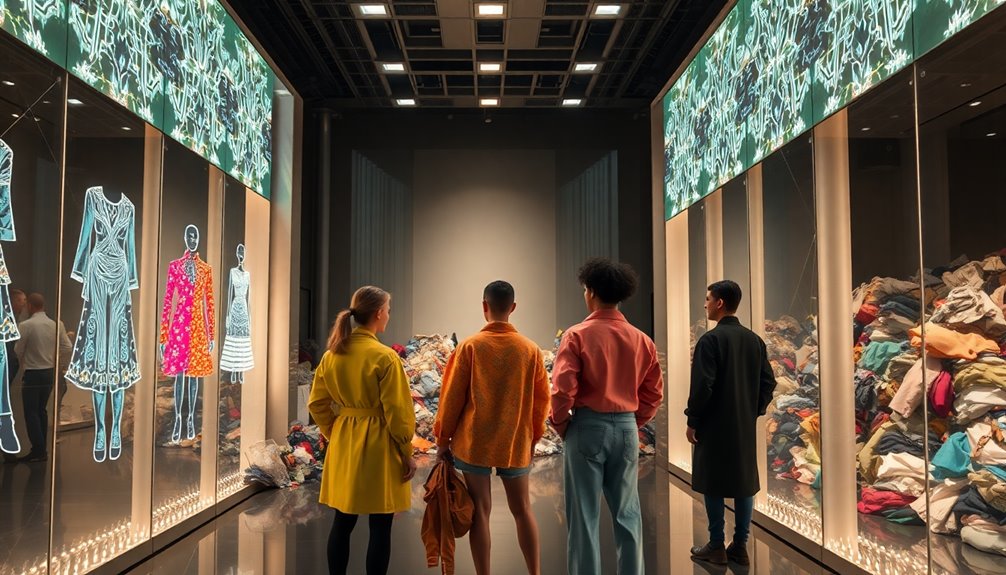
As AI speeds up fashion production, you might find yourself buying more clothes than ever before.
This rapid cycle not only leads to increased waste but also raises serious ethical concerns about labor conditions in the industry.
It's essential to reflect on how this efficiency could create a harmful loop of overconsumption and exploitation.
AI-Induced Production Acceleration
AI's integration into fashion production accelerates manufacturing processes, raising concerns about overconsumption.
With AI-driven data, brands can quickly adapt to trends, producing items at an alarming pace. This rapid response not only fuels the fast fashion cycle but also presents ethical challenges, as the urgency to meet consumer demand often overshadows sustainable practices.
The temptation to create more can lead to increased waste and exploitation of labor, as workers face grueling hours to keep up. Experts warn that this vicious cycle may worsen the environmental impact, entrenching a culture of disposable fashion.
It's essential to balance efficiency with responsibility, ensuring that advancements in technology don't compromise our commitment to ethical and sustainable fashion.
Increased Waste Generation
The rapid production capabilities enabled by AI have increased the risk of overconsumption in the fashion industry, leading to significant waste generation.
Fast fashion brands like Shein contribute heavily to environmental degradation, with an alarming carbon footprint of 16.7 million tonnes in 2023. This is largely driven by supply chains that prioritize speed over sustainability.
Consider these points:
- AI can offer efficiency but encourages excessive consumption.
- Increased waste generation from quick turnarounds impacts landfills.
- Fast fashion's cycle is perpetuated by AI advancements.
- A staggering 61% of Shein's emissions stem from its supply chain.
- Without ethical standards, pollution and exploitation may worsen.
- Additionally, the reliance on energy-efficient technology can help mitigate some of the environmental impacts associated with rapid production.
You can see how AI's role in fashion poses serious environmental risks.
Ethical Labor Concerns
While advancements in AI streamline production processes, they also raise alarming ethical labor concerns within the fashion industry.
The efficiency AI brings to fast fashion can lead to increased overconsumption, worsening pollution and waste issues. Reports show that workers in this sector, like those at Shein, often face grueling 75-hour work weeks, highlighting the exploitation tied to rapid production.
As AI optimization accelerates output, it can perpetuate a cycle of pollution and labor exploitation, with the fast fashion industry contributing 1.2 billion tonnes of carbon emissions yearly.
Without proper ethical standards, the potential for overconsumption grows, putting immense pressure on already strained labor practices and amplifying the industry's negative environmental impact.
Copyright and Ethical Concerns
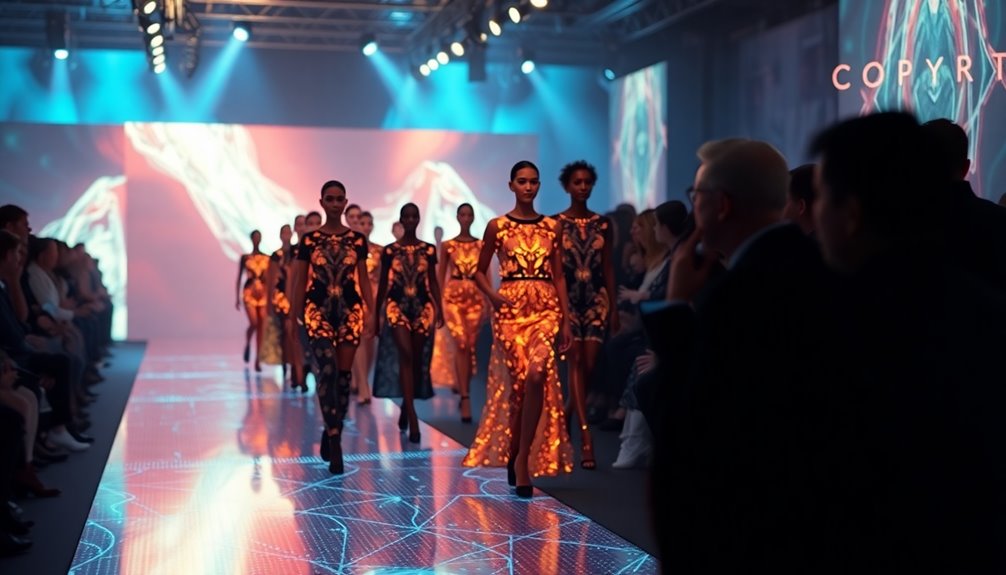
As you explore the intersection of AI and fashion, you'll encounter significant copyright infringement risks that challenge traditional design rights.
Companies like Shein have faced lawsuits for allegedly stealing artists' work, raising questions about ethical AI practices.
Maneuvering this complex landscape requires clear guidelines and regular audits to guarantee creative integrity and brand reputation.
Copyright Infringement Risks
Generative AI in fashion introduces complex copyright infringement risks that can catch companies off guard. As you navigate this landscape, consider the following challenges:
- Copyrighted Work: Using existing designs without permission can lead to lawsuits.
- Legal Vulnerabilities: Companies face uncertainties in intellectual property ownership due to evolving regulations.
- Algorithmic Trend Analysis: Relying on algorithms may inadvertently create similar designs, increasing the risk of infringement.
- Fashion Brands: Competition can intensify as brands utilize similar AI tools, risking repeated violations.
- Guidelines and Audits: Regular checks are essential to guarantee compliance and fair use of AI-generated content.
Ethical AI Practices
Steering through the ethical landscape of AI in fashion isn't just about avoiding copyright infringement; it's also about fostering a culture of integrity and respect for artistic expression.
You need to recognize that while algorithmic trend analysis can streamline design processes, it poses risks of systematic design theft. Without clear legal frameworks, the uncertainties around derivative works and intellectual property ownership can undermine creative innovation.
Companies facing lawsuits, like Shein, highlight the urgent need for ethical practices that protect artists' rights. Overreliance on similar algorithms could lead to an "algorithmic monoculture," stifling diverse artistic voices.
Embracing ethical AI practices is essential for a future where technology and creativity coexist harmoniously in the fashion industry.
Generative AI Applications in Fashion
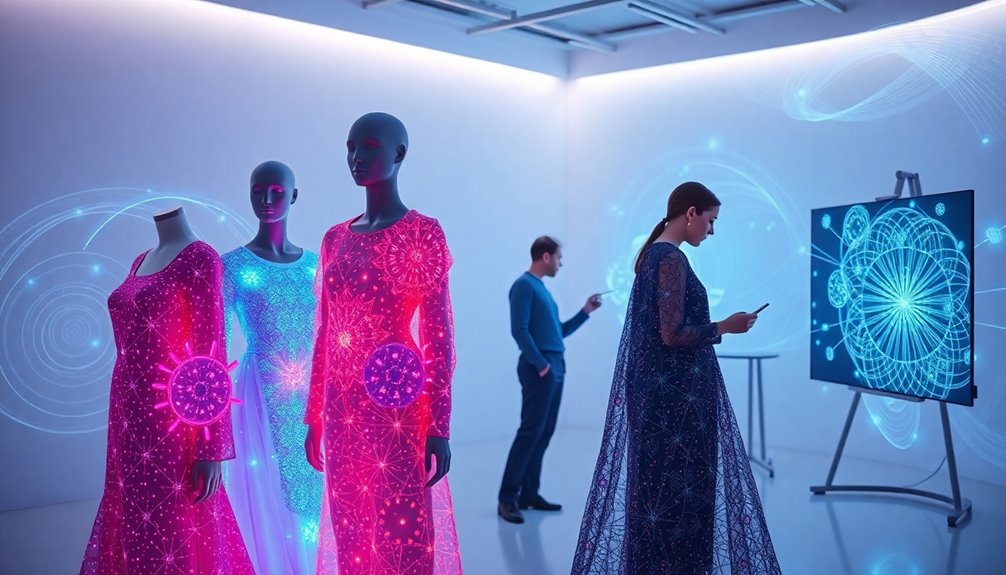
While traditional design processes can be time-consuming, the rise of AI applications is revolutionizing the fashion industry.
Generative AI in fashion accelerates the design process and enhances creativity, allowing you to transform sketches into high-fidelity designs in no time. This not only improves customer satisfaction but also helps boost sales through more engaging products.
- AI tools like DALL-E and Midjourney visualize ideas effectively
- Automated consumer segmentation tailors marketing strategies
- Real-time data analysis informs design decisions
- Diverse design options reduce waste and improve sustainability
- Generative AI could add up to $275 billion in profits
Embracing these innovations positions you to thrive in a competitive market while meeting evolving consumer demands.
Enhancing the Shopping Experience
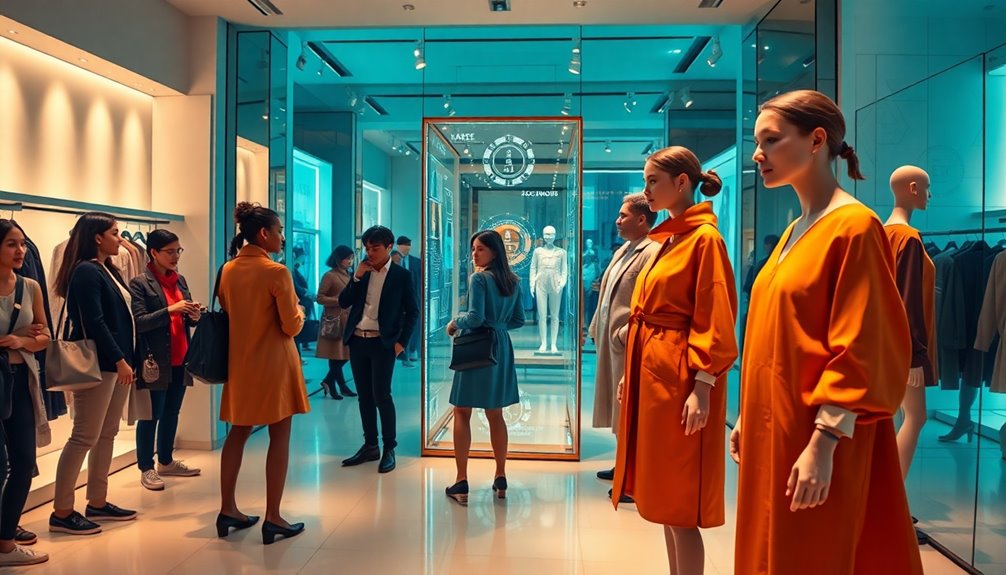
As AI reshapes design processes, it also transforms how you shop. By enhancing the shopping experience, AI-enabled chatbots provide personalized recommendations and styling advice, making your shopping journey smoother and more tailored.
These chatbots analyze your preferences and behaviors, delivering suggestions that resonate with your style. Additionally, virtual try-on technology lets you visualize how clothes fit your body type, reducing the likelihood of purchasing items that don't work for you.
This innovation minimizes return rates and boosts customer satisfaction. Greater personalization in marketing makes you feel valued, fostering loyalty and engagement.
With AI-powered features like voice-activated fittings, your shopping process becomes even more efficient, ensuring you enjoy every moment spent discovering new fashion. Moreover, the incorporation of eco-friendly practices in fashion design can align with consumer values, enhancing both satisfaction and sustainability.
Future Trends in AI Integration
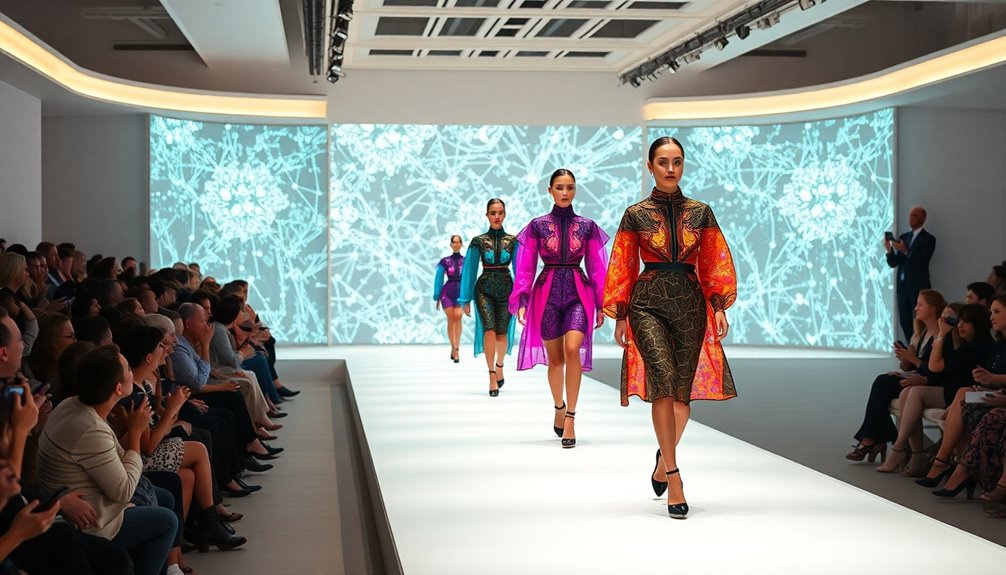
With AI poised to revolutionize the fashion industry, you can expect to see exciting trends that will reshape how brands operate and engage with consumers.
Here's what's on the horizon:
- AI could add between $150 billion to $275 billion in profits through improved operational efficiencies.
- Generative AI will enable rapid design creation and diverse options tailored to market demands.
- Enhanced virtual try-on technologies will personalize shopping experiences for various body types.
- AI will predict trends and analyze consumer behavior, helping brands anticipate market needs.
- Chatbots and personalized content will transform marketing, boosting consumer interaction and satisfaction.
- As holistic SEO practices evolve, brands will increasingly leverage AI to enhance their online presence and connect with consumers more effectively.
These advancements in fashion retailing are set to create a more efficient, sustainable, and engaging shopping experience for all.
Collaborations and Workforce Training
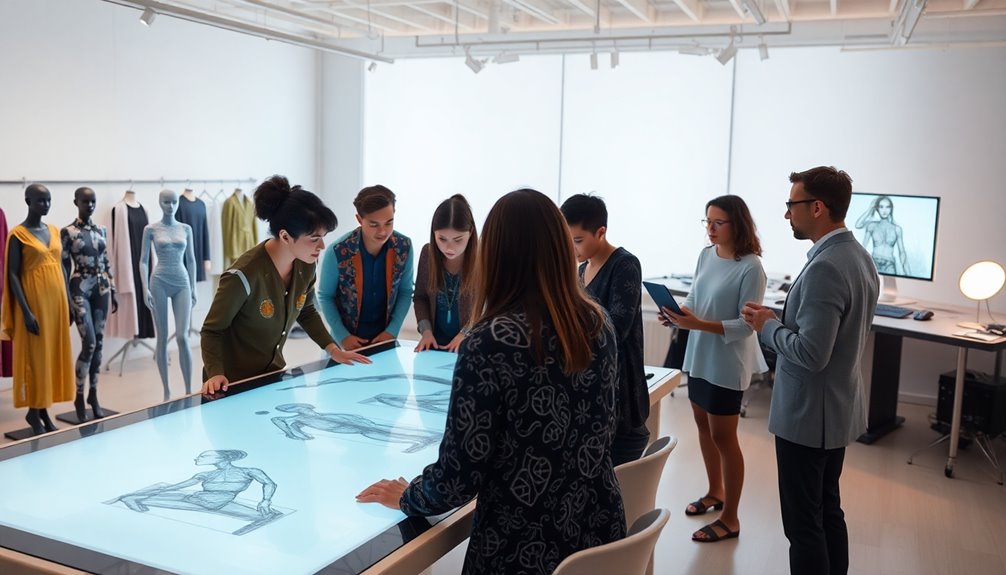
The integration of AI in fashion not only transforms design and consumer interaction but also highlights the need for effective collaborations and workforce training.
To leverage generative AI technologies, fashion businesses must invest in regular training programs, ensuring employees understand its limitations and capabilities.
By fostering clear roles between technical and non-technical staff, you can enhance collaborative dynamics, encouraging teamwork and innovation in AI integration.
Establishing strategic partnerships with generative AI experts, such as Microsoft or OpenAI, will further empower your brand to adapt to technological advancements.
Continuous experimentation with AI tools drives innovation, allowing you to explore new applications and improve operational efficiencies, keeping your business competitive in this rapidly evolving industry.
Frequently Asked Questions
What Is the Future of AI in Fashion?
The future of AI in fashion looks promising.
You'll see AI revolutionizing design processes, allowing for rapid creation of diverse styles tailored to your preferences.
With AI-driven analytics, brands will pinpoint trends and optimize their offerings, minimizing waste.
You'll also benefit from improved supply chain management, leading to more sustainable practices.
As human designers collaborate with AI tools, expect innovative creations that blend technology and creativity, enhancing your fashion experience like never before.
Will Fashion Designers Be Replaced by AI?
Will fashion designers be replaced by AI? It's a thought-provoking question that stirs unease.
While AI can churn out designs and spot trends faster than you can blink, it lacks the emotional depth and cultural nuances that only you possess.
Imagine a world where AI assists, not replaces, your creative spark.
The future lies in collaboration, where your unique vision, combined with AI's capabilities, creates innovative fashion that resonates deeply with people.
Is AI a Threat to the Fashion Industry?
You might see AI as a threat to the fashion industry, especially with its potential to compromise labor rights and creativity.
As production speeds up, workers could face longer hours, risking exploitation.
Plus, AI's role in fast fashion fosters overconsumption, harming the environment.
If companies rely too heavily on similar technologies, innovation may stagnate.
Without ethical guidelines, these issues could spiral, leading to a cycle of pollution and social injustice in fashion.
Why Can't the Fashion Industry Ignore AI Five Key Trends to Watch?
You can't ignore AI in fashion, especially with McKinsey estimating a potential profit boost of $150 billion to $275 billion from generative AI tools.
These innovations are revolutionizing design, enabling rapid creation of diverse concepts and aligning production with real-time consumer demand.
Plus, AI enhances customer experiences through virtual try-ons and personalized recommendations, making shopping more satisfying.
Staying aware of these trends is vital for brands wanting to thrive in a competitive market.
Conclusion
As you step into the vibrant world of fashion, it's clear AI isn't just a fleeting trend. Imagine a runway where algorithms and creativity dance together, crafting sustainable choices and tailored experiences. While the risks of overconsumption loom like shadows, the potential for ethical innovation shines bright. By embracing AI, you're not just watching the future unfold; you're shaping it, weaving technology and artistry into a fabric that redefines the industry for generations to come.

